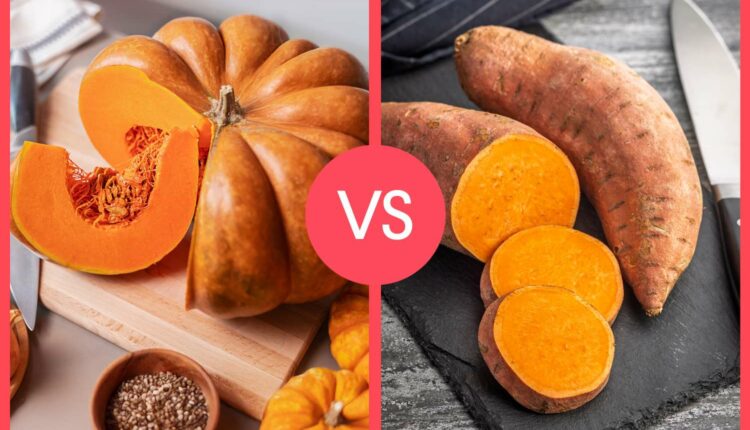©2021 Reporters Post24. All Rights Reserved.
Sweet potato and pumpkin are two vegetables that offer potential benefits for blood sugar management.
Is Sweet Potato or Pumpkin Better for Blood Sugar?
Sweet potato (Ipomoea batatas) and pumpkin (Cucurbita pepo) are both thought to have beneficial effects on blood sugar, but in different ways.
- Pumpkin contains fewer carbohydrates than sweet potato. One cup of pumpkin contains just 8 grams (g) of carbohydrates, while one cup of sweet potato contains 27 g of carbohydrates.12 Low-carbohydrate foods, like pumpkin, don’t raise blood sugar as much as high-carbohydrate foods.3
- Sweet potatoes are a good source of fiber, which helps blunt blood sugar spikes. One cup of sweet potato contains about 4 g of dietary fiber, which slows digestion and aids the uptake of sugar (glucose) from your food into your cells.2 Increasing dietary fiber consumption has been associated with improved outcomes for individuals with high blood sugar or type 2 diabetes.4
- Pumpkin and sweet potato have similar glycemic indexes. Both vegetables have a glycemic index of around 60, which is considered moderate. However, pumpkin and sweet potato are considered suitable sources for managing high blood sugar due to their high nutrient density.5
- Pumpkin has fewer calories than a sweet potato. A pattern of regularly eating more calories than you need is associated with an increased risk of high blood sugar and type 2 diabetes. Studies show that reducing overall calorie intake may improve blood sugar management.6
- Sweet potato contains complex carbohydrates that slow digestion. Amylopectin is a type of complex carbohydrate found in sweet potatoes, and it is digested slowly due to its unique structure. This may help you feel fuller for longer between meals and consume fewer calories throughout the day.7
Whether you choose pumpkin or sweet potato for blood sugar management, portion sizes are key. Eating either vegetable (or any food) in excessive amounts may lead to blood sugar spikes.
Pairing sweet potatoes or pumpkins with protein may also help curb blood sugar spikes. Evidence suggests that consuming fiber-rich and protein-rich foods together slows down digestion and glucose release, which benefits blood sugar management.8
Sweet Potato vs. Pumpkin: Which Is More Nutritious?
While sweet potatoes and pumpkins share some common nutrients, their overall nutritional profiles differ.
| Nutrients in 1 Cup of Cubed Sweet Potato vs. Pumpkin | ||
|---|---|---|
| Sweet Potato2 | Pumpkin1 | |
| Calories | 114 | 30 |
| Protein | 2.1 g | 1.2 g |
| Total Fat | 0.1 g | 0.1 g |
| Carbohydrates | 27 g | 7.5 g |
| Dietary Fiber | 4 g | 0.6 g |
| Calcium | 40 mg | 24 mg |
| Iron | 0.8 mg | 0.9 mg |
| Magnesium | 33 mg | 14 mg |
| Potassium | 448 mg | 394 mg |
| Vitamin C | 3.2 mg | 10.4 mg |
| Folate | 15 mcg | 19 mcg |
| Vitamin A | 943 mcg | 494 mcg |
| Beta-Carotene | 11,300 mcg | 3,600 mcg |
| Vitamin E | 0.3 mg | 1.2 mg |
| Vitamin K | 2.4 mcg | 1.3 mcg |
- Sweet potatoes are higher in most nutrients, making them a more nutrient-dense option overall compared to pumpkins.
- Both contain beta-carotene, an antioxidant that may reduce the risk of high blood sugar and type 2 diabetes.9
- Pumpkin may be better for blood sugar management due to being lower in calories and carbs.
- However, sweet potatoes are still suitable for managing high blood sugar levels thanks to their fiber, vitamins, and minerals.
What Other Benefits Do Sweet Potatoes and Pumpkins Have?
Sweet potato and pumpkin may have additional health benefits, as outlined in the following table.
| Additional Potential Health Benefits of Sweet Potato and Pumpkin | ||
|---|---|---|
| Sweet Potato | Pumpkin | |
| Immunity | Nutrients in sweet potatoes may reduce inflammation and alter the immune response, which may help reduce the risk of certain diseases.10 | Pumpkin contains antioxidants and other compounds that may support the immune system and help fight off illness.11 |
| Heart Health | Fiber and antioxidants in sweet potatoes may promote heart health by reducing inflammation and LDL cholesterol, and increasing HDL cholesterol.12 | Pumpkin and pumpkin seeds may help regulate blood pressure and reduce your overall risk for heart disease.13 |
| Weight Management | Regularly replacing a high-calorie, low-fiber meal with nutrient-dense sweet potatoes may promote weight loss.14 | Pumpkin and pumpkin seeds are low in calories and moderately high in fiber, which may support weight loss efforts.15 |
| Eye Health | As a rich source of beta-carotene, sweet potatoes may support eye health and help prevent diseases like macular degeneration.16 | In addition to beta-carotene, pumpkin also contains lutein and zeaxanthin, two compounds that also promote eye health.15 |
| Digestion | Dietary fiber in sweet potatoes feeds beneficial bacteria in the gut and may promote a healthy gut microbiome, which is essential to digestion.17 | Polysaccharides in pumpkin may help increase beneficial bacteria in the gut and support overall gut health.18 |
Ways to Enjoy Sweet Potato and Pumpkin
You can enjoy sweet potato and pumpkin in similar ways. Ways to incorporate sweet potato and pumpkin into your diet include:
- Roasted and eaten as a side dish
- Added to soups or stews
- Included in a stir-fry
- Cubed and eaten with a warm salad
- Sliced and added to pizza
- Mixed into smoothies or sauces
- Mashed and added to homemade veggie burgers
- Baked into breads, muffins, cakes, or pancakes
Numerous recipes and other ideas for incorporating sweet potatoes and pumpkins into meals are available online.
Alternatively, please consult with a healthcare provider or registered dietitian nutritionist (RD/RDN) to learn more about these vegetables and how to incorporate them into your diet.


